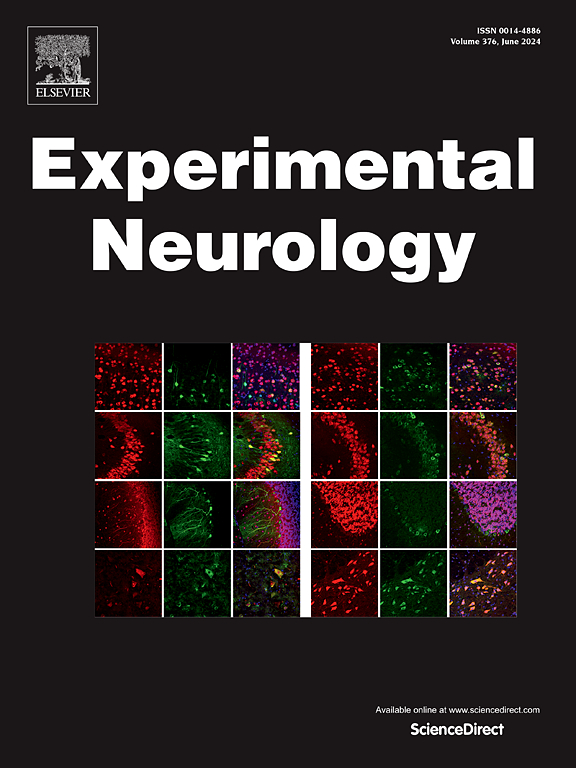DRP1活动的时钟控制在术后认知功能障碍中的作用。
IF 4.6
2区 医学
Q1 NEUROSCIENCES
引用次数: 0
摘要
术后认知功能障碍(POCD)是麻醉和手术后常见的临床问题。既往研究认为POCD的发病与昼夜节律紊乱密切相关,但其发病机制尚不明确。越来越多的证据表明,线粒体结构是由生物钟协调的,DRP1起着至关重要的作用。尽管如此,DRP1如何通过昼夜节律中断介导线粒体动力学影响POCD仍不清楚。为了研究这一点,小鼠在6 h的1.5 %异氟醚麻醉下,从Zeitgeber时间zt14至ZT20诱导POCD。HT-22细胞在体外长时间暴露于异氟醚中。通过y形迷宫和恐惧条件反射测试评估认知功能。采用Q-PCR和Western blot检测相对蛋白表达量。使用Mini-Mitter连续监测小鼠的总体运动节奏。通过Mito-Tracker成像检查线粒体形态。测定ATP和ROS水平评价线粒体功能。异氟醚麻醉损害了海马中DRP1活动的时钟控制。DRP1磷酸化节律的破坏破坏了昼夜ATP的产生,影响了线粒体形态和功能,加剧了昼夜节律紊乱,最终导致小鼠认知缺陷。Mdivi-1(一种特异性DRP1抑制剂)预处理能够重建线粒体形态和功能,恢复昼夜ATP的产生和节律,从而减轻异氟醚麻醉引起的认知障碍。本研究提示DRP1昼夜节律活性对海马线粒体能量代谢的调节可能在小鼠POCD发病机制中发挥重要作用。本文章由计算机程序翻译,如有差异,请以英文原文为准。
The role of clock control of DRP1 activity involved in postoperative cognitive dysfunction
Postoperative cognitive dysfunction (POCD) is a prevalent clinical issue following anesthesia and surgery. The onset of POCD, which is closely linked to circadian rhythm disturbance in previous studies, yet the underlying mechanism remains elusive. There is increasing evidence showed that mitochondrial architecture is coordinated by the circadian clock which DRP1 playing a crucial role. Nonetheless, how DRP1's mediation of mitochondrial dynamics influences POCD through circadian rhythm disruption is still unclear. To investigate this, mice were subjected to 6 h of 1.5 % isoflurane anesthesia from Zeitgeber Time ZT 14 to ZT20 to induce POCD. HT-22 cells underwent prolonged exposure to isoflurane in vitro. Cognitive function was assessed using the Y-maze and fear conditioning tests. Q-PCR and Western blot analyses were performed to measure relative protein expression. Mice's gross movement rhythms were continuously monitored using Mini-Mitter. Mitochondrial morphology was examined via Mito-Tracker imaging. ATP and ROS level were measured to evaluate mitochondrial function. Isoflurane anesthesia compromised the clock control of DRP1 activity in the hippocampus. This disruption of DRP1 phosphorylation rhythm impaired circadian ATP production, affected mitochondrial morphology and function, exacerbated circadian rhythm disturbances, and ultimately led to cognitive deficits in mice. Pretreatment with Mdivi-1, a specific DRP1 inhibitor, managed to reconstruct mitochondrial morphology and function, restore circadian ATP production and rhythm, thereby alleviating the cognitive impairment induced by isoflurane anesthesia. This study suggests that circadian DRP1 activity's regulation of mitochondrial energy metabolism in the hippocampus may play a significant role in the pathogenesis of POCD in mice.
求助全文
通过发布文献求助,成功后即可免费获取论文全文。
去求助
来源期刊

Experimental Neurology
医学-神经科学
CiteScore
10.10
自引率
3.80%
发文量
258
审稿时长
42 days
期刊介绍:
Experimental Neurology, a Journal of Neuroscience Research, publishes original research in neuroscience with a particular emphasis on novel findings in neural development, regeneration, plasticity and transplantation. The journal has focused on research concerning basic mechanisms underlying neurological disorders.
 求助内容:
求助内容: 应助结果提醒方式:
应助结果提醒方式:


